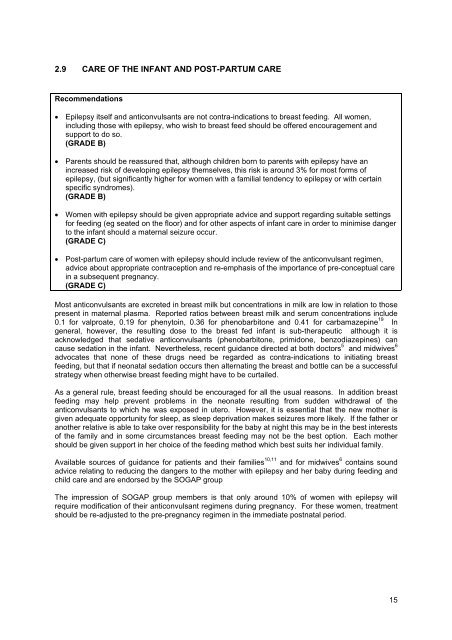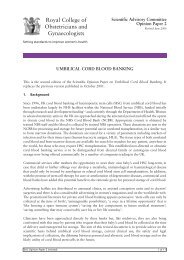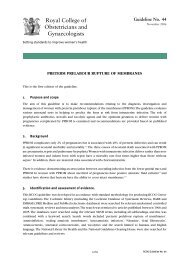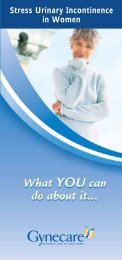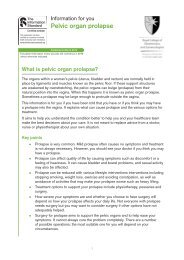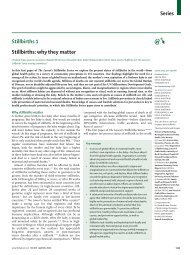The Management of Pregnancy in Women with ... - Dr Paul P Fogarty
The Management of Pregnancy in Women with ... - Dr Paul P Fogarty
The Management of Pregnancy in Women with ... - Dr Paul P Fogarty
You also want an ePaper? Increase the reach of your titles
YUMPU automatically turns print PDFs into web optimized ePapers that Google loves.
2.9 CARE OF THE INFANT AND POST-PARTUM CARE<br />
Recommendations<br />
• Epilepsy itself and anticonvulsants are not contra-<strong>in</strong>dications to breast feed<strong>in</strong>g. All women,<br />
<strong>in</strong>clud<strong>in</strong>g those <strong>with</strong> epilepsy, who wish to breast feed should be <strong>of</strong>fered encouragement and<br />
support to do so.<br />
(GRADE B)<br />
• Parents should be reassured that, although children born to parents <strong>with</strong> epilepsy have an<br />
<strong>in</strong>creased risk <strong>of</strong> develop<strong>in</strong>g epilepsy themselves, this risk is around 3% for most forms <strong>of</strong><br />
epilepsy, (but significantly higher for women <strong>with</strong> a familial tendency to epilepsy or <strong>with</strong> certa<strong>in</strong><br />
specific syndromes).<br />
(GRADE B)<br />
• <strong>Women</strong> <strong>with</strong> epilepsy should be given appropriate advice and support regard<strong>in</strong>g suitable sett<strong>in</strong>gs<br />
for feed<strong>in</strong>g (eg seated on the floor) and for other aspects <strong>of</strong> <strong>in</strong>fant care <strong>in</strong> order to m<strong>in</strong>imise danger<br />
to the <strong>in</strong>fant should a maternal seizure occur.<br />
(GRADE C)<br />
• Post-partum care <strong>of</strong> women <strong>with</strong> epilepsy should <strong>in</strong>clude review <strong>of</strong> the anticonvulsant regimen,<br />
advice about appropriate contraception and re-emphasis <strong>of</strong> the importance <strong>of</strong> pre-conceptual care<br />
<strong>in</strong> a subsequent pregnancy.<br />
(GRADE C)<br />
Most anticonvulsants are excreted <strong>in</strong> breast milk but concentrations <strong>in</strong> milk are low <strong>in</strong> relation to those<br />
present <strong>in</strong> maternal plasma. Reported ratios between breast milk and serum concentrations <strong>in</strong>clude<br />
0.1 for valproate, 0.19 for phenyto<strong>in</strong>, 0.36 for phenobarbitone and 0.41 for carbamazep<strong>in</strong>e 19 In<br />
general, however, the result<strong>in</strong>g dose to the breast fed <strong>in</strong>fant is sub-therapeutic although it is<br />
acknowledged that sedative anticonvulsants (phenobarbitone, primidone, benzodiazep<strong>in</strong>es) can<br />
cause sedation <strong>in</strong> the <strong>in</strong>fant. Nevertheless, recent guidance directed at both doctors 5 and midwives 6<br />
advocates that none <strong>of</strong> these drugs need be regarded as contra-<strong>in</strong>dications to <strong>in</strong>itiat<strong>in</strong>g breast<br />
feed<strong>in</strong>g, but that if neonatal sedation occurs then alternat<strong>in</strong>g the breast and bottle can be a successful<br />
strategy when otherwise breast feed<strong>in</strong>g might have to be curtailed.<br />
As a general rule, breast feed<strong>in</strong>g should be encouraged for all the usual reasons. In addition breast<br />
feed<strong>in</strong>g may help prevent problems <strong>in</strong> the neonate result<strong>in</strong>g from sudden <strong>with</strong>drawal <strong>of</strong> the<br />
anticonvulsants to which he was exposed <strong>in</strong> utero. However, it is essential that the new mother is<br />
given adequate opportunity for sleep, as sleep deprivation makes seizures more likely. If the father or<br />
another relative is able to take over responsibility for the baby at night this may be <strong>in</strong> the best <strong>in</strong>terests<br />
<strong>of</strong> the family and <strong>in</strong> some circumstances breast feed<strong>in</strong>g may not be the best option. Each mother<br />
should be given support <strong>in</strong> her choice <strong>of</strong> the feed<strong>in</strong>g method which best suits her <strong>in</strong>dividual family.<br />
Available sources <strong>of</strong> guidance for patients and their families 10,11 and for midwives 6 conta<strong>in</strong>s sound<br />
advice relat<strong>in</strong>g to reduc<strong>in</strong>g the dangers to the mother <strong>with</strong> epilepsy and her baby dur<strong>in</strong>g feed<strong>in</strong>g and<br />
child care and are endorsed by the SOGAP group<br />
<strong>The</strong> impression <strong>of</strong> SOGAP group members is that only around 10% <strong>of</strong> women <strong>with</strong> epilepsy will<br />
require modification <strong>of</strong> their anticonvulsant regimens dur<strong>in</strong>g pregnancy. For these women, treatment<br />
should be re-adjusted to the pre-pregnancy regimen <strong>in</strong> the immediate postnatal period.<br />
15


